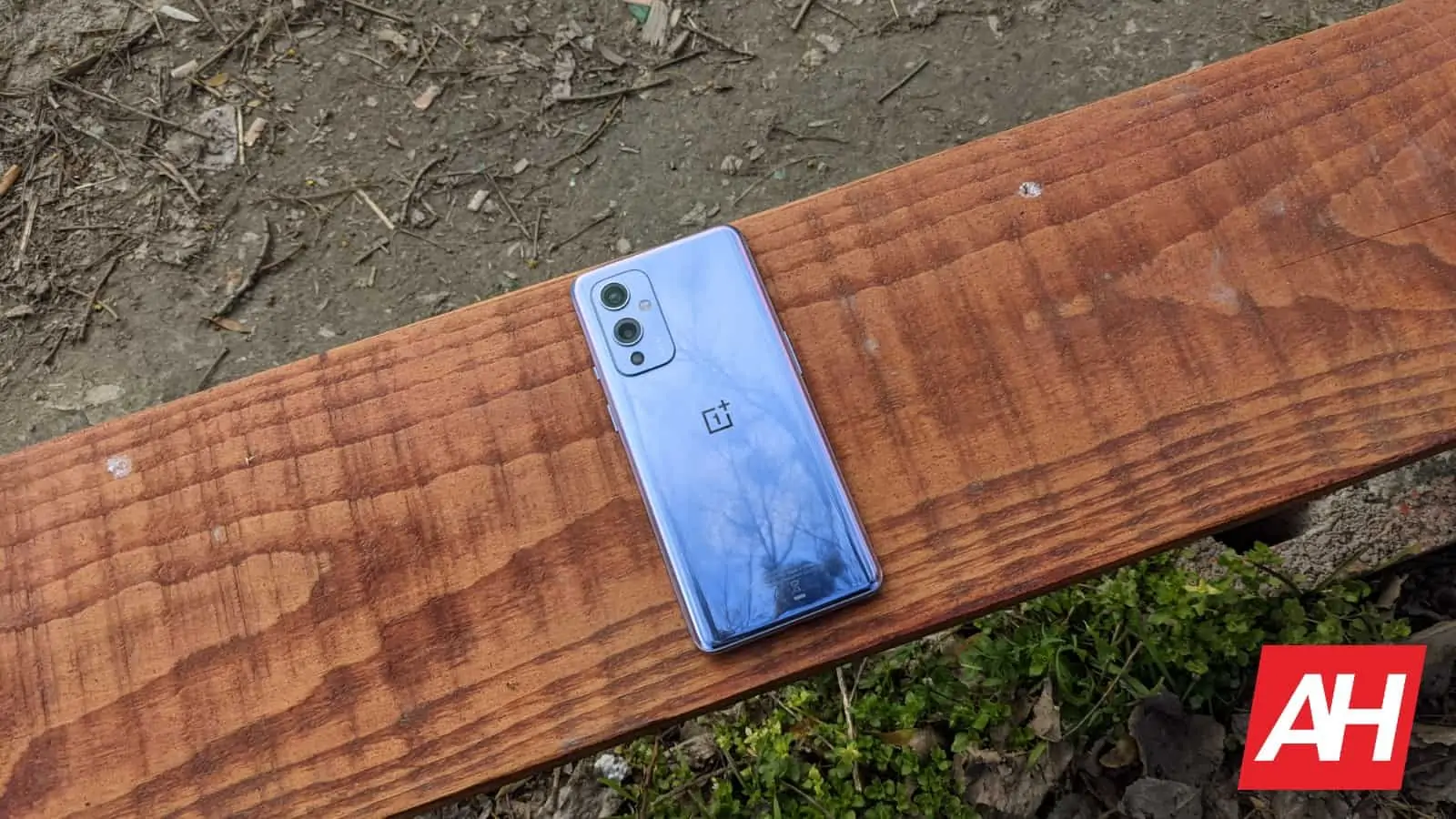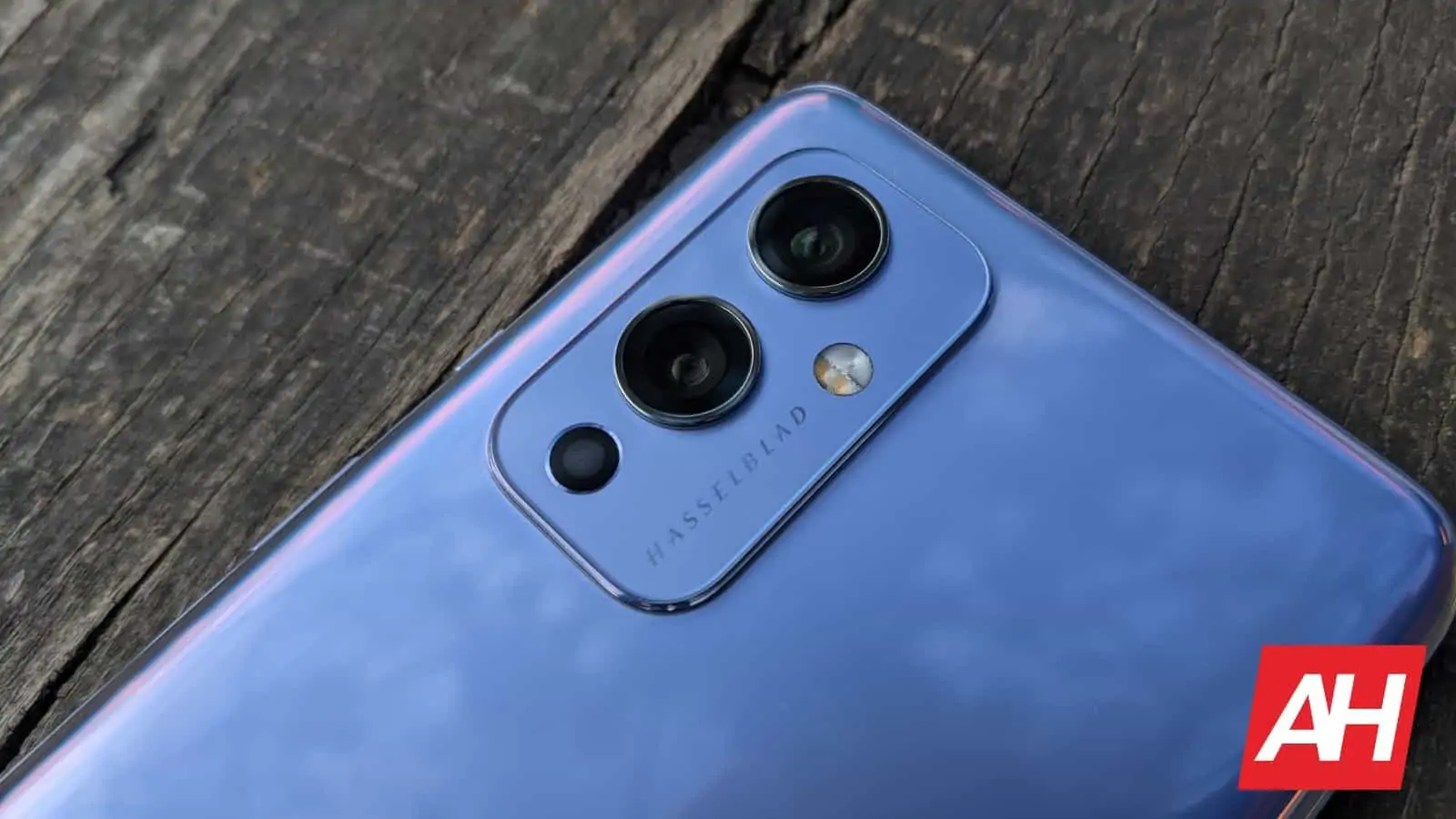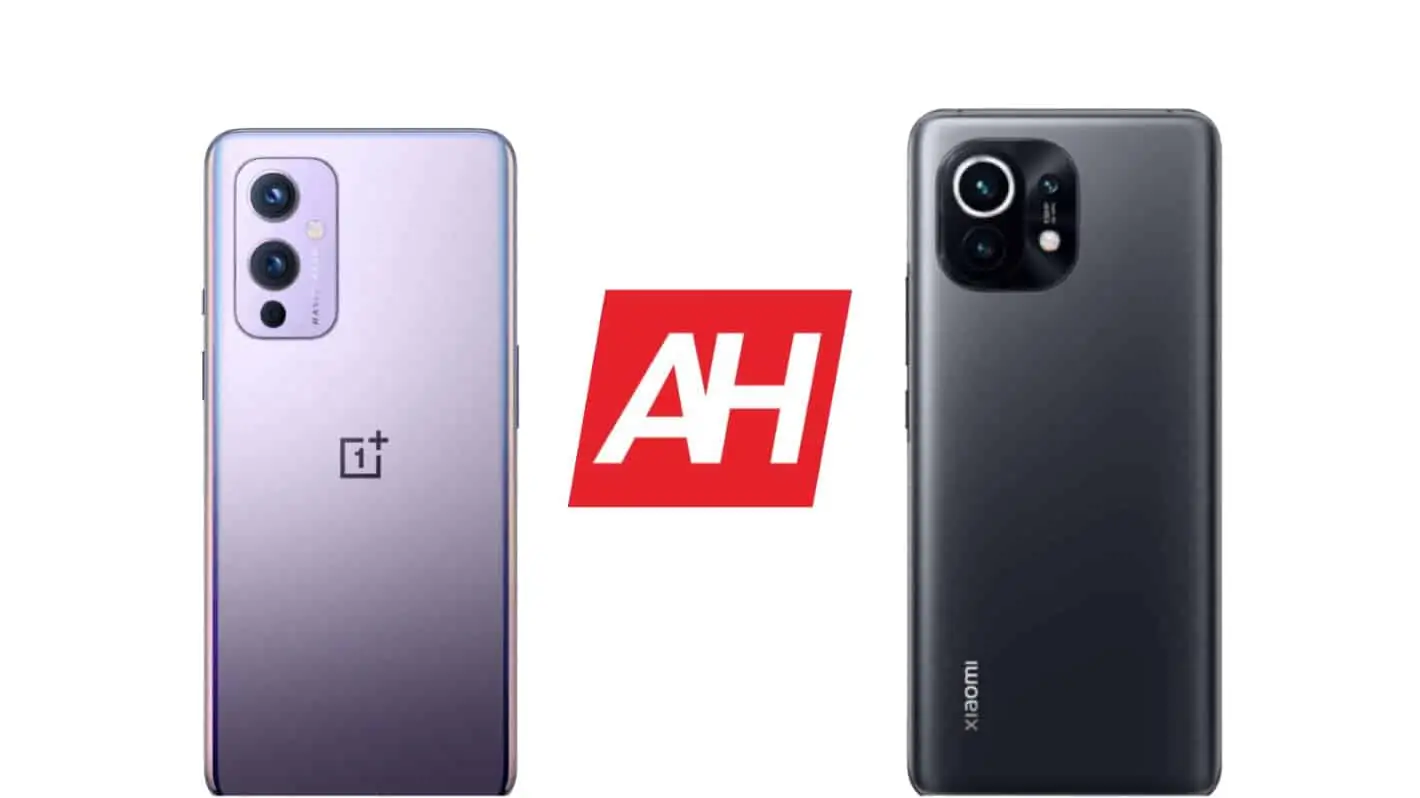We’ve compared the Xiaomi Mi 11 Ultra vs OnePlus 9 Pro a while back. Those are the two most powerful handsets from Xiaomi and OnePlus. This time around, we’re here to check out their other two flagship-grade phones, we’ll compare the OnePlus 9 vs Xiaomi Mi 11. Both of those phones are inferior to their larger siblings, but they are still high-end smartphones, and for some of you may be even better purchasing options.
In some ways, these two phones are quite similar. Their designs are not too different, while they’re also similar in terms of size. There are quite a few differences here to talk about, though. Each of them stands out in its own way. First, we’ll list their specifications, and then move to other sections, such as design, display, performance, battery, and so on. That being said, let’s compare the OnePlus 9 vs Xiaomi Mi 11, shall we.
Specs
| OnePlus 9 | Xiaomi Mi 11 | |
| Screen size | 6.55-inch fullHD+ AMOLED display (120Hz refresh rate) | 6.81-inch WQHD+ AMOLED quad-curve DotDisplay (120Hz adaptive refresh rate) |
| Screen resolution | 2400 x 1080 | 3200 x 1440 |
| SoC | Qualcomm Snapdragon 888 | Qualcomm Snapdragon 888 |
| RAM | 8GB/12GB (LPDDR5) | 8GB (LPDDR5) |
| Storage | 128GB/256GB (UFS 3.1), non-expandable | 128GB/256GB (UFS 3.1); Non-Expandable |
| Rear cameras | 48MP (Sony IMX689, f/1.8 aperture, 1.12um pixel size 48MP images, 2.24um pixel size 12MP images (4-in-1 binning), 7P lens, EIS) 50MP (ultra-wide, Sony IMX766, 7P lens, f/2.2 aperture, Freeform Lens) 2MP (monochrome) |
108MP (f/1.85 aperture, 7P lens, OIS, 1/33-inch sensor size, 0.8um pixel size, 1.6um 4-in-1 Super Pixel) 13MP (f/2.4 aperture, 123-degree FoV) 5MP (telemacro, f/2.4 aperture, AF 3cm-10cm) |
| Front cameras | 16MP (Sony IMX471, 1.0um pixel size, EIS, Fixed Focus, f/2.4 aperture) | 20MP (0.8um pixel size, 1.6um 4-in-1 Super Pixel, f/2.2 aperture) |
| Battery | 4,500mAh, non-removable, 65W wired charging, 15W wireless charging, reverse wireless charging | 4,600mAh, Non-Removable, 55W fast wired charging, 50W fast wireless charging, 10W reverse wireless charging |
| Dimensions | 160 x 74.2 x 8.7mm (North America & Europe) 160 x 73.9 x 8.1mm (India & China) |
164.3 x 74.6 x 8.06mm |
| Weight | 192 grams (North America & Europe) 183 grams (India & China) |
196 grams |
| Connectivity | 5G, LTE, NFC, Bluetooth 5.2, Wi-Fi, USB Type-C | 5G, LTE, NFC, Bluetooth 5.2, Wi-Fi, USB Type-C |
| Security | In-display fingerprint scanner (optical) | In-display fingerprint scanner (optical) |
| OS | Android 11 OxygenOS 11 |
Android 11 MIUI 12.5 |
| Price | $729 / $829 | €799 |
| Buy | OnePlus | Xiaomi / AliExpress |
OnePlus 9 vs Xiaomi Mi 11: Design
Both of these smartphones come with a glass back, but their frames are made from different materials. The OnePlus 9’s is made out of plastic, while Xiaomi opted for a frame made out of metal. You wouldn’t even notice that the OnePlus 9’s frame is made out of metal, though, it feels really good. Both phones have a display camera hole in the top-left corner, and both have fairly thin bezels. The Mi 11 has a curved display, unlike the OnePlus 9.
Their rear cameras are placed in similar sports. The entire camera setup sits in the top-left corner on the back, though they look different, of course, and the two companies use different camera setups. The Xiaomi Mi 11 is slightly taller, and wider than the OnePlus 9. Depending on the variant, they’re either identical in thickness, or almost identical. The OnePlus 9 comes in two different models, one with wireless charging, and one without, which reflects on its thickness.

In regards to weight, the Xiaomi Mi 11 is heavier, that goes for both its glass and leather variants. Both phones feel really good in the hand, and are not too large. Do note that these are large devices, though, there’s nothing compact about them. Both phones are quite slippery in the hand, and are not ideal for one-hand usage. The OnePlus 9 is maybe a better choice for one-hand usage due to its size. All in all, both are really well-made, and are comfortable to use.
OnePlus 9 vs Xiaomi Mi 11: Display
The OnePlus 9 features a 6.55-inch fullHD+ (2400 x 1080) Fluid AMOLED display. This is a 120Hz display, which is flat, and it supports HDR10+ content. This panel also gets quite bright at 1,100 nits peak brightness. Corning’s Gorilla Glass 5 is included here to protect the display of the device. We’re looking at a 20:9 display aspect ratio here, in case you’re wondering, while the display offers 402 PPI.
The Xiaomi Mi 11, on the other hand, has a 6.81-inch QHD+ (3200 x 1440) panel. This is an AMOLED display as well, and it’s a 120Hz panel. This display is curved, compared to the one on the OnePlus 9, and it does support HDR10+ as well. The Mi 11’s display gets quite bright at 1,500 nits peak brightness. So, it does get brighter than the OnePlus 9’s panel. This display also offers a 20:9 aspect ratio, and it is protected by the Gorilla Glass Victus. We’re looking at 515 PPI here.
In real-life use, both displays are excellent. They offer really vibrant colors, and excellent viewing angles. The Mi 11 does get a bit brighter, but you can see both displays outside without a problem, even in direct sunlight. Those OLED blacks are deep, as they should be. The two displays do feel different to use, as one is flat and the other is not. You should ask yourself what you prefer, a flat display, or a curved one, and go from there. As both of these panels are excellent, fluid, and more than sharp enough.
OnePlus 9 vs Xiaomi Mi 11: Performance
In regards to performance, well, both of these phones deliver. Both of them are fueled by the Snapdragon 888 SoC, one of the two most powerful SoCs from Qualcomm. The rest of their internals are also quite powerful. Both come in either 8GB or 12GB of RAM variants, with 128GB or 256GB of internal storage. Android 11 comes pre-installed on both phones, though their proprietary skins are considerably different.
These hardware specs do mix well with their software builds. Both phones offer excellent performance, to say the least. Regular, everyday tasks are a breeze for both phones. We did not notice any slowdown during such tasks, none whatsoever. No matter how much you multitask, both phones will keep their cool. Even if you delve into some gaming, you should be more than fine.
These two phones can run pretty much every game on the Play Store, and they can do that at very high graphical settings as well. Such hardware is more or less an overkill in regards to performance, and these two phones will likely keep performing at a high level for several years, at least. So, you should be good in that regard, if you decide to purchase either of them.
OnePlus 9 vs Xiaomi Mi 11: Battery
The OnePlus 9 features a 4,500mAh battery, while the Mi 11 comes with a 4,600mAh unit. Now, the OnePlus 9 does have a lower-res display, which is considerably smaller than the Mi 11’s. And yes, as a result, the OnePlus 9 does offer better battery life. The OnePlus 9 actually offered better battery life than its ‘Pro’ sibling, at least in our testing. The phone can easily go north of 6 hours of screen-on-time, and most of the time we were able to get to 6.5 hours. That will depend on your usage, of course, heavily. We did not really game all that much, so do note that.
The Xiaomi Mi 11 was not able to provide us with such high numbers. It was closer to 5.5 hours of screen on time, though its battery life did improve a bit since launch. Both of these phones should be able to provide you with more than enough battery life. The only type of user that may have issues is the power user, especially if gaming is thrown into the mix. Everyone else will be more than happy here.
If you, by any chance, end up needing a refill ahead of time, you’ll be glad to know that fast charging is supported here. The OnePlus 9 offers 65W fast wired charging, and 15W wireless charging (Europe and North America only). The Mi 11, on the other hand, offers 55W wired, 50W wireless, and 10W reverse wireless charging. So, the Mi 11 is a bit more versatile, and you may want to get it if you prefer wireless charging. If wireless charging speed doesn’t matter to you, the OnePlus 9 is good enough. The OnePlus 9 does offer faster charging overall, though.
OnePlus 9 vs Xiaomi Mi 11: Cameras
The OnePlus 9 has two cameras on the back, 48 (main) and 50-megapixel units (ultrawide). The Xiaomi Mi 11, on the flip side, includes three cameras back there. It has a 108-megapixel main camera, backed by 13 and 5-megapixel ultra-wide and macro units, respectively. The OnePlus 9 is not exactly lacking in the versatility department, as that freeform ultrawide camera can take some amazing macro photos. It doubles as a macro camera. I’d even argue it does a better job than a dedicated macro camera on the Mi 11.

When it comes to main cameras, they’re both good, but not great. They do a good job in good lighting, for sure. The colors are accurate, though a bit better on the OnePlus 9. The images turn up sharp, with good white balance, and dynamic range. When the light goes away, the Mi 11 does a bit better job. The OnePlus 9 does not have OIS on its main camera, and that does impact its low light performance to a degree. The difference is not huge, but it’s noticeable. Images turn up sharper on the Mi 11, when it comes to such conditions.
Audio
Neither of these two phones has an audio jack, unfortunately. You’ll need to utilize Type-C headphones, a dongle, or simply use Bluetooth for wireless connection. That being said, both phones do offer stereo speakers. They are similar when it comes to quality and audio output. They can provide rather loud and sharp audio, with minimal distortion at the very highest of volumes.
These speakers do provide well-balanced audio as well. They’re not great, but are really good. The same goes for audio via a good pair of headphones. It is well balanced across the spectrum, and you’ll even get some bass out of the whole experience. Not many people will have complaints when it comes to the audio here, that’s for sure.

